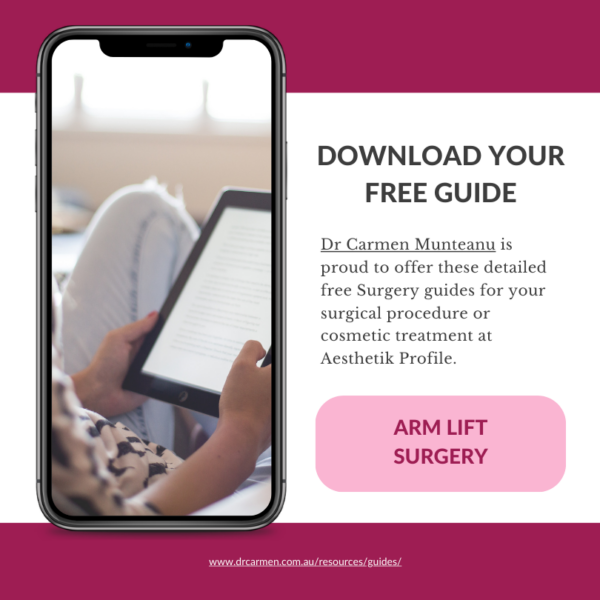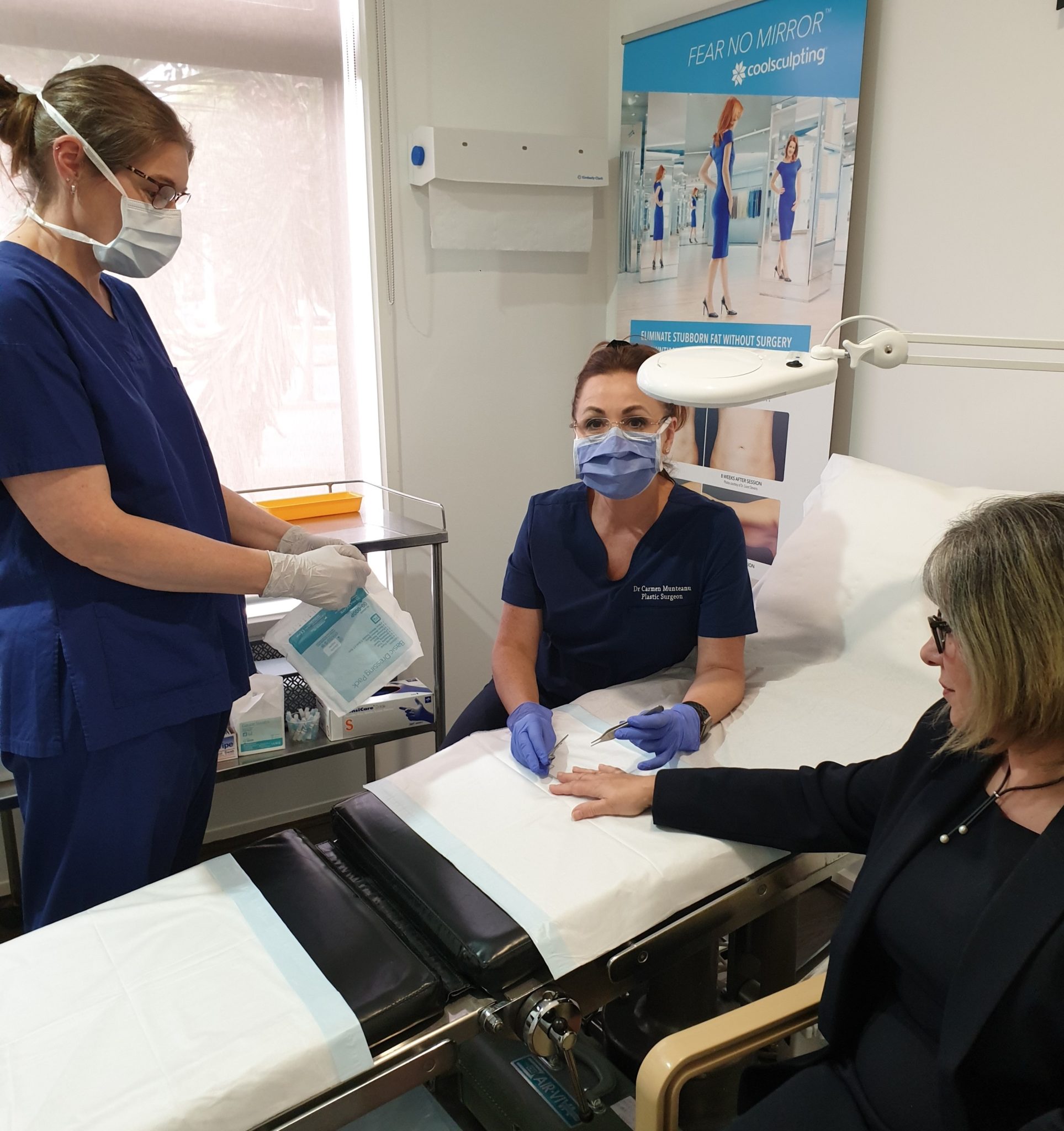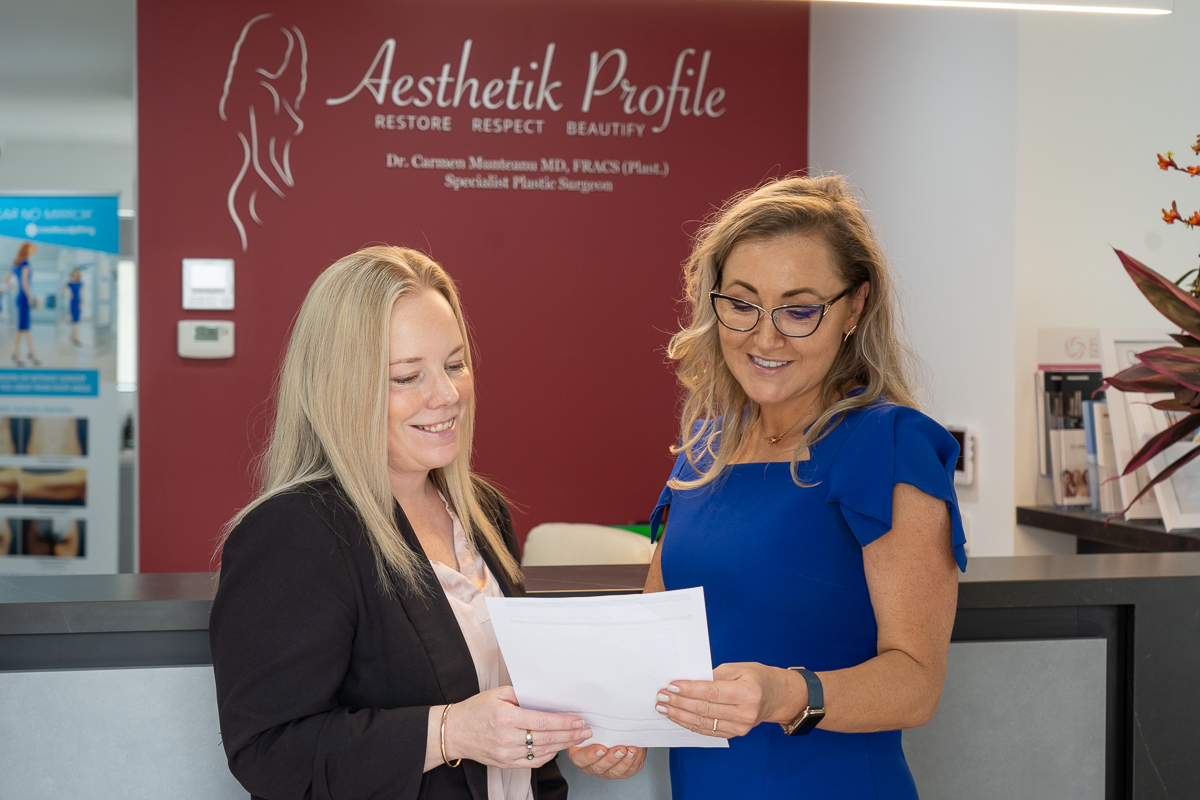Causes and Solutions for Swelling and Bruising after Arm Lift Surgery
More commonly known as an Arm Lift, the importance of post-operative care in Brachioplasty surgery can’t be overstated. It’s a critical phase that plays a significant role in how quickly you recover, how well you manage post-surgery symptoms like swelling and pain, and ultimately, how satisfied you are with the final results. From following medication guidelines to lifestyle adjustments and regular check-ups, each aspect of post-operative care is designed to help you heal in the best way possible. So, as you prepare for your arm lift surgery, remember that the steps you take after the procedure are crucial in shaping your recovery and overall experience.
Dr Carmen Munteanu MD, FRACS (Plas), is a highly proficient and empathetic Specialist Plastic Surgeon in Melbourne. She stands as one of the most in-demand female Plastic Surgeons in Melbourne, specialising in aesthetic body contouring, including Arm Lift procedures.
Download Dr Carmen’s Guide to Arm Lift Surgery

Why Does Swelling and Bruising Occur After Arm Lift Surgery?
Swelling and bruising are natural bodily responses to trauma or injury, and in the context of an arm lift surgery, they’re almost inevitable. But why exactly do they occur?
· The Surgical Process and Tissue Damage
During an arm lift surgery, incisions are made to remove excess skin and fat. This process inevitably causes some level of tissue damage, including to the blood vessels beneath the skin. When blood vessels are damaged or broken, blood leaks out into the surrounding tissue. This is what forms a bruise.
· The Role of Inflammation
Swelling, on the other hand, is largely due to inflammation. When your body undergoes surgery, it triggers an inflammatory response as a part of the healing process. This involves the release of various chemicals and the rushing of blood to the affected area, which can result in swelling.
· Blood and Fluid Accumulation
Both swelling and bruising involve the accumulation of fluids. In the case of a bruise, it’s mostly blood that accumulates under the skin. With swelling, it’s a combination of blood and other bodily fluids. These fluids are part of the body’s natural healing process, but their accumulation is what we see as swelling and bruising.
· The Impact of Surgical Technique
The extent of swelling and bruising can also depend on the surgical technique used. More invasive procedures are likely to cause more tissue damage, leading to more pronounced swelling and bruising. That’s why choosing an experienced plastic surgeon is crucial; they can employ techniques that minimise tissue damage, thereby reducing the extent of swelling and bruising you experience.
· Individual Factors
It’s also worth noting that individual factors like age, skin type, and overall health can influence how much you bruise or swell. For instance, older individuals may find that they bruise more easily than younger people. Those with certain medical conditions or who are taking specific medications may also experience more significant bruising and swelling.
· Gravity’s Pull
Don’t underestimate the power of gravity. After surgery, gravity can pull the accumulated fluids downward, exacerbating swelling and bruising. That’s why elevation strategies are often recommended post-surgery.
When to Expect Swelling and Bruising to Subside
Knowing when to expect swelling and bruising to subside can give you a better sense of your recovery timeline and help you plan your post-operative life more effectively
Short-Term
In the immediate aftermath of your arm lift surgery, it’s completely normal to experience significant swelling and bruising. Here’s what you can expect in the short term:
- First 48 Hours: This is when swelling and bruising are usually at their peak. You’ll likely notice that your arm looks puffy and discoloured. Don’t be alarmed; this is a normal part of the healing process
- One Week Post-Op: By the end of the first week, you should start to see a gradual reduction in swelling and bruising. However, your arm will still look and feel different than usual
- Two Weeks Post-Op: At this point, a noticeable amount of swelling and bruising should have subsided. You’ll likely be more comfortable moving your arms, although you should still be cautious and follow Dr Carmen’s guidelines
Long-Term
While the most noticeable symptoms subside within the first few weeks, it’s important to understand that complete healing takes time. Here’s what you can expect in the long term:
- One Month Post-Op: By now, most of the bruising should be gone, and swelling should have significantly reduced. However, some minor swelling may still be present, especially towards the end of the day or after physical activity
- Three Months Post-Op: At this stage, you should see a more natural arm contour as the swelling continues to go down. You’ll likely feel more at ease with your new appearance, although minor swelling might still occur occasionally
- Six Months to One Year: This is the period when you can expect to see the final results of your arm lift surgery. Any residual swelling should have resolved by this point, revealing the new shape and contour of your arm
Medical Approaches to Reduce Bruising and Swelling
After an arm lift surgery, it’s common to experience both bruising and swelling. While these symptoms are a natural part of the healing process, they can be uncomfortable. Fortunately, there are several medical approaches to manage these symptoms effectively. Here’s a detailed look at the options:
Prescription Medications
- Anti-Inflammatory Drugs: Medications like ibuprofen are often prescribed to control inflammation, which in turn helps reduce both swelling and bruising. These medications can also help manage post-operative pain
- Antibiotics: While they don’t directly reduce bruising or swelling, antibiotics can prevent infections that might worsen these symptoms
- Blood Thinners: In some cases, Dr Carmen might recommend medications to prevent blood clotting, which can help reduce bruising. However, these are generally used with caution to avoid complications
Over-the-Counter Options
- Non-Prescription Anti-Inflammatory Medication: Over-the-counter drugs like Advil can also be effective for reducing swelling and bruising. Always consult your plastic surgeon before taking any non-prescription medications
- Topical Creams: Some creams and ointments are designed to reduce bruising and swelling. Ingredients like arnica can be effective, but it’s essential to consult Dr Carmen before applying any topical treatments
Specialised Medical Equipment
- Compression Garments: These garments are designed to apply consistent pressure on the surgical area, helping to reduce both swelling and bruising. They also support the healing tissues, making your recovery more comfortable
- Cold Compress: Applying a cold compress can be effective in reducing both bruising and swelling. The cold helps to constrict blood vessels, reducing fluid accumulation and discoloration
Follow-Up Appointments and Monitoring
- Regular Check-Ups: Scheduled visits to your plastic surgeon are essential for monitoring your recovery. Dr Carmen can assess the level of bruising and swelling and adjust your treatment plan accordingly
- Imaging Tests: In some cases, your plastic surgeon might recommend imaging tests like an ultrasound to assess fluid accumulation and tissue healing, although this is less common
Natural Remedies to Reduce Swelling and Bruising
While medical approaches are often the first line of treatment for reducing swelling and bruising after an arm lift surgery, many people also find relief in natural remedies. These can be used in conjunction with your medical treatment plan, but always consult Dr Carmen before trying any new remedies. Here are some natural options you might consider:
Herbal Supplements
- Arnica: This is a popular herbal remedy known for its anti-inflammatory properties. It’s available in both topical and oral forms and can help reduce swelling and bruising
- Bromelain: Found in pineapples, this enzyme has anti-inflammatory effects and can help reduce swelling. It’s often available in supplement form
- Turmeric: Known for its anti-inflammatory properties, turmeric can be taken in capsule form or used to make a warm drink. The active ingredient, curcumin, helps reduce inflammation
Essential Oils
- Lavender Oil: This essential oil has anti-inflammatory and soothing properties. You can add a few drops to a carrier oil and gently massage it into the affected area, but make sure to do a patch test first to rule out any allergic reactions
- Tea Tree Oil: Known for its antiseptic properties, tea tree oil can help prevent infections that might worsen swelling. However, it should be diluted with a carrier oil before application
Dietary Changes
- Increase Water Intake: Staying hydrated can help flush out toxins and reduce fluid retention, thereby helping to reduce swelling
- Limit Salt Intake: Excessive salt can lead to fluid retention. Cutting back can help manage swelling
- Anti-Inflammatory Foods: Incorporating foods like berries, green tea, and leafy greens can help reduce inflammation in the body, aiding in the reduction of swelling and bruising
Home Therapies
- Cold Compress: A simple cold compress can constrict blood vessels and reduce swelling and bruising. Apply a cold pack wrapped in a cloth to the affected area for 15-20 minutes at a time
- Elevation: Keeping the affected arm elevated can help reduce swelling by allowing fluids to drain away from the area
Compression Garments after Arm Lift Surgery
After an arm lift surgery, one of the most recommended items for your post-operative care is a compression garment. These garments are designed to offer support to the surgical area, helping to reduce swelling and improve the overall healing process. Let’s explore the types of compression garments available and how to choose the right one for you.
Types of Compression Garments
- Sleeve-Style Garments: These are the most common type of compression garments for arm lift surgery. They resemble a tight-fitting sleeve that covers the arm from the wrist to the armpit or even up to the shoulder
- Vest-Style Garments: For those who have also had surgery in the upper body area, a vest-style garment might be recommended. This type covers not just the arms but also the chest and back
- Adjustable Garments: Some compression garments come with adjustable straps or Velcro closures, allowing you to adjust the level of compression as the swelling decreases
- Zipped vs. Non-Zipped: Some garments come with a zipper to make it easier to put on and take off, while others are pull-on styles. The choice between the two often comes down to personal preference
Elevation to Reduce Swelling and Bruising
Elevation is a simple yet effective technique that can significantly help in reducing swelling and bruising after an arm lift surgery. By elevating the affected area, you allow gravity to assist in draining excess fluid away from the surgical area. Let’s look at the best practices for elevation and when it’s most effective to elevate your arms.
Best Practices
- Height Matters: Ideally, you should elevate your arms so that they are above the level of your heart. This maximises the effectiveness of gravity in pulling fluids away from the surgical site
- Support: Use pillows or foam wedges to support your arms while elevating them. Make sure the support is firm enough to keep your arms in place but soft enough to be comfortable
- Positioning: While lying down is the most effective position for elevation, you can also do it while sitting. Just make sure your arms are well-supported and above heart level
- Avoid Bending: Try to keep your arms as straight as possible during elevation. Bending your arms can restrict fluid flow, reducing the effectiveness of elevation
- Check for Numbness: While elevation is generally safe, keeping your arms in the same position for an extended period can sometimes lead to numbness. If you experience this, adjust your position and consult your plastic surgeon if the issue persists
When to Elevate
- Immediately Post-Op: Start elevating your arms as soon as possible after the surgery. The sooner you begin, the more effective it will be in reducing initial swelling and bruising
- During Sleep: Elevating your arms while sleeping can be very effective, as it’s a time when you’re least likely to move around, allowing for consistent elevation
- After Activity: Any form of physical activity, even minimal, can increase blood flow to the surgical area, potentially increasing swelling. Elevate your arms after any significant movement
- Scheduled Intervals: If possible, try to elevate your arms at regular intervals throughout the day. For example, you could aim for 15-20 minutes of elevation every 2-3 hours
- Listen to Your Body: If you notice increased swelling or bruising, it’s a good indication that you should elevate your arms
Cold and Heat Therapy
Cold and heat therapy are both effective methods for managing post-operative symptoms like swelling and bruising after an arm lift surgery. Each has its own set of benefits and best-use scenarios.
Ice Packs
- Immediate Relief: Ice packs provide quick relief from swelling and pain by constricting blood vessels and reducing blood flow to the affected area
- Timing: The best time to use an ice pack is within the first 48 hours after surgery, when swelling and bruising are usually at their peak
- Frequency: Aim for 15–20-minute intervals of cold therapy, making sure to take breaks in between to prevent frostbite
- Protection: Always wrap the ice pack in a cloth or towel to protect your skin from direct contact with the ice
- Types of Ice Packs: You can use commercial gel ice packs, or make your own by placing ice cubes in a plastic bag and wrapping it in a cloth
- Avoid Direct Contact: Never place an ice pack directly on the skin as it can cause frostbite or skin irritation
Warm Compresses
- Increased Blood Flow: Warm compresses work by increasing blood flow to the affected area, which can help in the later stages of healing by bringing nutrients and oxygen to the surgical site
- Timing: Warm compresses are generally recommended after the initial 48-hour period has passed and the acute phase of swelling has subsided
- Frequency: Like with ice packs, aim for 15–20-minute intervals, taking breaks in between
- Protection: Use a cloth to wrap the warm compress and protect your skin from excessive heat
- Types of Warm Compresses: You can use a commercial warm compress, or make your own by soaking a cloth in warm water and wringing it out
- Test Temperature: Always test the temperature of the warm compress on another part of your body before applying it to the surgical area to avoid burns
FAQs about Swelling and Bruising after Arm Lift Surgery

How long does swelling last after arm lift surgery?
- Swelling is most prominent in the first 48 hours after surgery and generally starts to subside within a week. However, minor swelling can persist for several weeks or even months. It’s essential to follow Dr Carmen’s guidelines for managing swelling effectively.
Can I exercise after arm lift surgery?
- Exercise is generally not recommended in the immediate aftermath of arm lift surgery. Your plastic surgeon will provide you with a detailed timeline for when you can resume physical activities, which is usually after a few weeks, depending on your specific condition and rate of healing.
What foods should I avoid to reduce swelling?
- Foods high in salt and sugar can contribute to fluid retention and swelling. It’s best to stick to a balanced diet rich in anti-inflammatory foods like berries, leafy greens, and lean proteins.
Is it normal to have bruising along with swelling?
- Yes, bruising and swelling are common side effects after arm lift surgery. Both are part of the body’s natural healing process. While bruising usually subsides within a couple of weeks, swelling may take longer to go down.
How tight should my compression garment be?
- Your compression garment should be snug but not so tight that it causes discomfort or restricts blood flow.
Further Reading about Arm Surgery with Dr Carmen
- Read Dr Carmen’s Arm Lift Surgery Page
- Read Dr Carmen’s Blog about Can You Shrink Loose Skin After Weight Loss?
- Read Dr Carmen’s Blog about Arm Lipo vs Arm Lift
- Read Dr Carmen’s Blog about Solutions for Loose Arm Skin after Weight Loss
- Read Dr Carmen’s Blog about How to Reduce Scars after Arm Lift
- Read Dr Carmen’s Blog about When Can I Exercise After Arm Lift Surgery
Medical References about Swelling and Bruising after Arm Lift Surgery
- Arm Contouring: Review and Current Concepts – PubMed
- Complications associated with brachioplasty: a literature review – PubMed
- Upper Arm Lift – The Aesthetic Society
- Arm Lift – Mayo Clinic


